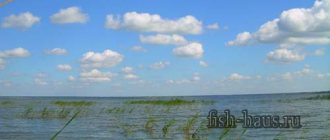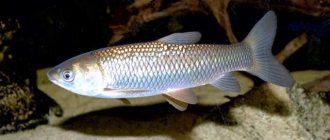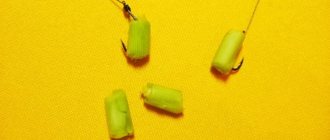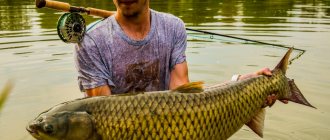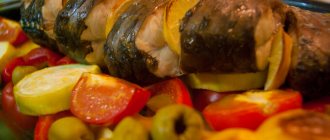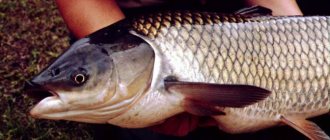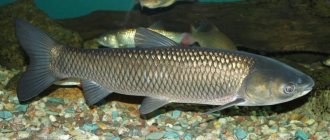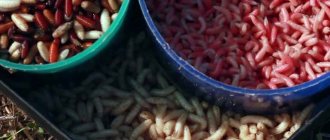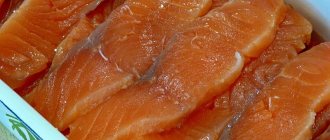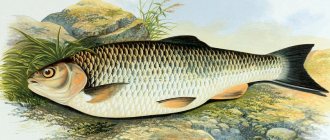Catching grass carp on reeds
Published on September 14, 2015 by Evgeniy Timonin in the section White Cupid Number of people who read the article: 16,874
Catching grass carp for many fishermen seems unrealistic, although other fishermen are quite successful in catching this freshwater giant, which can reach incredible sizes, and its weight can be measured in tens of kilograms.
Why don't you catch him too? To begin with, I would advise you to read the article “Catching Grass Carp” to understand all the intricacies of this fishing. Well, in this article we will talk about a specific bait - reeds.
Catching grass carp with reeds can bring very good results if done correctly. Remember and try.
Feeding grass carp
Without bait, catching grass carp with reeds or any other bait is doomed to failure.
No, of course, the probability of a bite always remains, but the effectiveness of fishing without bait will be no more than 10% of the real possibilities. You can increase this percentage to 100 with the help of bait.
The only exception is if you simply leave bottom gear throughout the reservoir overnight, and only come to check it in the morning. Then you can do without bait.
Grass carp is a very voracious fish and in a day it can eat exactly as much food as it weighs! That is, a cupid weighing 5 kg can easily eat 5 kg of food. This is despite the fact that a 5 kg cupid is considered not very large - average. Even at small stakes where grass carp are bred and raised, you can find individuals weighing more than 10 kg or more. Therefore, you need to take bait seriously.
Any porridge is suitable as bait - pea, millet, pearl barley, bran, cake, halva, ground seeds, cookies, corn, etc. You can use store-bought bait, but then it will cost much more, because one package of bait is not enough when catching grass carp .
Feed the point of intended fishing well and periodically feed this place, then even the fish that have already approached the feeding place will return here again and again.
Many novice fishermen are somehow afraid of feeding their fishing spot and look with enthusiasm at fishermen who generously feed their fishing spot, they say, here they are, professionals!!! But in fact, there is nothing complicated in feeding the fishing spot. You can buy a bucket of mixed feed, add boiled potatoes to it, and now you have a good bait that will not hurt your pocket at all, but will help you catch the giant carp. Try it and you will definitely succeed.
How to catch grass carp using reeds
There is nothing difficult about catching grass carp using reeds. The main task for you is to buy tackle with a hair and get reed leaves. Well, reed leaves can be picked directly while fishing. Tackle with a hair is usually used for carp fishing with boilies and is sold in any fishing store. Let's say you have the necessary equipment and reeds. What to do next?
Next you will need a special awl with a hook for rigging with a hair, you can also buy it at a fishing store, it is not expensive, and stoppers to secure the reed attached to the hair. Now you are fully armed and all that remains is to properly bait the bait - reeds.
To do this, take a sheet of reeds, fold it in half lengthwise and tear it into 2 equal long halves. Place one half on top of the other and tear off pieces of about 2-3 cm along the entire length.
Place these pieces into an even stack. The height of the stack should also be several centimeters.
As a result, you get a nice tasty “bunch” of reeds for cupid, which he will definitely want to try.
Now you need to pierce this column of reeds with an awl, hook a loop of hair on our rig and pull it through our stack of reeds. We put stops and our tackle is ready for fishing. You can place a large ball of polystyrene foam in front of the reeds by a hair, it will be better, because the bait will turn out to be floating, which will have a very good effect on the carp’s bite.
Always have several fishing rods in your arsenal, and try a different length of hair on the rig on each fishing rod. Sometimes cupid pecks on a 2-3 cm hair, and sometimes exclusively on longer ones.
In order to consolidate and better understand the material you have read, I suggest watching a video that shows in detail how to make gear for catching carp with reeds.
Catching carp with reeds, video
Tag: cupid
Please rate the article:(6
Source: https://rybkolov.ru/lovlya-belogo-amura-na-kamysh/
Catching grass carp on reeds
Catching grass carp for many fishermen seems unrealistic, although some fishermen are quite successful in catching this freshwater giant, which can reach incredible sizes, and its weight can be measured in tens of kilograms.
Why don't you catch him too? To begin with, I would advise you to read the article “Catching White Cupid” to understand all the intricacies of this fishing. Well, in this article we will talk about a specific bait - reeds.
Catching grass carp with reeds can bring very good results if done correctly. Remember and try.
Feeding grass carp
Without bait, catching grass carp with reeds or any other bait is doomed to failure.
No, of course, the probability of a bite remains forever, but the effectiveness of fishing without bait will be no more than 10% of the real possibilities. You can increase this percentage to 100 with the help of bait.
The only exception is if you simply leave bottom gear throughout the reservoir overnight, and only come to test it in the morning. Then you can do without bait.
Grass carp is a very voracious fish and in a day it can eat as much food as it weighs! That is, a cupid weighing 5 kg can easily eat 5 kg of food. This is despite the fact that a 5 kg cupid is considered not very large - average. Even at small stakes where grass carp are bred and raised, you can find individuals weighing more than 10 kg or more. Therefore, you need to take bait seriously.
Any porridge is suitable as bait - pea, millet, pearl barley, compartments, cake, halva, ground seeds, cookies, corn, etc. You can use store-bought bait, but then it will become much more expensive, because one package of bait is not enough when catching grass carp .
Feed the point of intended fishing well and periodically feed this point, then even the fish that has already approached the feeding place will return here again and again.
Many novice fishermen are somehow afraid of feeding fishing points and look with enthusiasm at fishermen who generously feed their fishing points, they say, here they are, professionals!!! But in fact, there is nothing complicated in feeding the fishing spot. You can buy a bucket of mixed feed, add boiled potatoes to it, and now you have a good bait that will not hurt your pocket at all, but will help you catch the giant cupid. Try it and you will definitely succeed.
How to catch grass carp using reeds
There is nothing difficult about catching grass carp using reeds. The main task for you is to buy tackle with a hair and get reed leaves. Well, you can pick reed leaves right while fishing. Tackle with a hair is usually used for carp fishing with boilies and is sold in any fishing store. Let's say you have the necessary equipment and reeds. What to do next?
For further you will need a special awl with a hook for rigging with a hair, it can also be purchased at a fishing store, it is not expensive, and stoppers to secure the reed attached to the hair. Now you are fully armed and all that remains is to properly bait the bait - reeds.
To do this, grab a sheet of reeds, fold it in half lengthwise and tear it into 2 equal long halves. Place one half on top of the other and tear off pieces about 2-3 cm along the entire length.
Place these pieces into an even stack. The height of the stack should also be a few centimeters.
As a result, you get a nice tasty “bundle” of reeds for Cupid, which he will definitely want to try.
Now you need to pierce this column of reeds with an awl, hook a loop of hair on our rig and stretch it through our stack of reeds. We put stops and our tackle is ready for fishing. You can place a large ball of foam plastic on a hair's breadth in front of the reeds, it will be better, because the bait will come out floating, which will have a very good effect on the carp's bite.
Always have several fishing rods in your arsenal; try different lengths of hair on the rig on any fishing rod. Sometimes cupid pecks on a hair of 2-3 cm, and sometimes exclusively on longer ones.
In order to consolidate and better understand the material you have read, I suggest watching a video that shows in detail how to make gear for catching carp with reeds.
Source: https://atemifishing.ru/lovlya-belogo-amura-na-kamysh/
When to catch Cupid.
As soon as the water has warmed up well and the first shoots of algae or reeds have appeared, you can safely go in search of White Amur. As a rule, this is the middle or end of spring, it all depends on your geographical location and the temperature of the water. At this time, when there is not much food, your bait will stand out well against the background of sparse aquatic vegetation, which means your chances of catching a good trophy are high. At the height of summer, when there is a lot of food and the water is hot like fresh milk, the bite weakens, but does not stop on hot summer days, in order to attract the attention of Amur to your bait, it is worth increasing the bait base.
If you were unable to catch a good trophy in the spring, this can be done closer to mid-autumn, around the end of September or beginning of October. Also read the article about catching crucian carp in the spring. Nature gives us another chance to take first place in catching White Cupid. Every day there is less and less food in the reservoir, and those pitiful remains are no longer as tasty and juicy as they were in the summer. And you need to prepare for winter, so Bely eats everything that comes to his hand.
In general, we catch White Cupid from May to October inclusive. In the summer you will have to dodge to attract Amur's attention to your bait. Advice. When the temperature drops, the carp goes to the pits where the water has not yet cooled down, but by lunchtime, when the water gradually warms up, it goes out into shallow water to feed. It has been noticed that large individuals are active mainly in the morning or evening, while smaller ones remain active all day.
In cloudy weather the best bite rates are achieved. That is, even large carp bite perfectly all day. At night is also not a bad time for a good bite. The fact is that Amur fish are quite timid, and night is the calmest time of the day when you can eat in peace, so when going for White Amur at night, do not waste your time.
Regarding gear, we can say that there is no main universal gear for White Amur. Both float and bottom tackle are suitable here. The whitefish is quite a strong fish, so choose strong and long rods because you won’t be able to raise a more or less good trophy near the shore. How to choose a spinning rod.
Directly about baits and baits
The only condition is that your bait must be buoyant since Amur’s mouth is not sharpened for collecting food from the bottom. Therefore, a little foam is added to the bait for buoyancy. Before you go fishing, soak the foam with the juice of reeds, dill, and green peas. Fresh foam will repel fish.
A few words about White Cupid’s favorite baits
Corn, peas, potatoes, reed shoots are the most common baits. You can also use all possible cocktails from the products listed above. Don’t forget about the makukha (cake), this product will add flavor to the bait and bait.
If you don't have sunflower cake, try adding fresh dill. You can also use pea leaves, corn leaves, and aloe leaves without thorns as bait. Another feature of Cupid’s mouth is that his lips are quite strong; the white one clamps the bait tightly in his mouth and crushes it, thereby simply crumbling and stealing the bait.
Catching grass carp on reeds
Slowly and little by little, grass carp is moving from the category of “exotic-theoretical” fish into a fairly ordinary trophy of milk-weed and floater.
Fishermen are still trying to find the key to this trickster, which is used to stock many lakes, ponds and reservoirs with fish these days.
And the fact that grass carp grows up to 20 kg gives fishing a unique flavor, because even specimens of 3-4 kg fight on the tackle in such a way that it takes your breath away!
Fishing practice has revealed that cupid that is not so careful is inaccessible. It has been proven that classic fishing from above is not the only one - it also takes well from the bottom. By the way, it is on the bottom that this fish flies unpredictably when bream bites on bloodworms, maggots, corn, pasta, and in clean places, and not in the grass. Such surprises force fishermen to take a closer look at the carp.
Through the efforts of experienced fishermen, the biting period has also been calculated, which is not at all limited to the spring, when there is still practically no grass and the cupid is hungry.
Normal catches have been going on since mid-July - with maximum warming of the water and the beginning of the death of some algae.
This period is quite long and lasts until the autumn cold snap, and on fish farms carp are caught even in the pre-winter period, when carp and crucian carp are no longer heard of.
The main problem is the selection of bait, because this fish does not eat anything; it is around this topic that most of the controversy and experimentation occurs.
Often when fishing, the problem arises: what to use to catch grass carp today. An important conclusion: cupid is not an absolute vegetarian.
And the more of this fish there is in a reservoir, the less aquatic vegetation there is, the higher the chance of catching a bunch of dung worms or crawling.
Fishermen have noticed that the more worms on the hook, the sharper and more confident the bite; they usually bait 4-5 dung beetles or a couple of crawlers, piercing each one twice in the center so that the ends hang freely and wriggle - cupid really likes this. And in case of pressure changes or unexpected cold snaps, bloodworms can be a great help - they don’t want anything, but they take a bunch of bloodworms, the main thing is that the small things don’t spoil the fishing.
And yet, in most cases, cupid prefers baits of plant origin. In first place in terms of catchability are young shoots of aquatic plants (reed, reeds, pondweed, mud, etc.).
Experienced fishermen successfully fish with a retrieve, releasing a miniature loaded foam float 100 meters downstream. The rig is without a weight, the bait goes almost on top, the distance from the float to the hook is about a meter.
They also catch carp by hooking a young leaf of reed about 20 cm long onto a hook, wrapping the leaf with thread in two places - to the shank of the hook and above to the fishing line; a small tail of greenery is left below the hook. This fish responds well to the donk, baited with a grain of corn, then a bunch of young mud is wound on the hook.
In some reservoirs, bottom fishermen praise plant-animal sandwiches, for example, this: half-centimeter tubes are cut with a sharp knife, 3-4 pieces are put on a leash through a hook - one long cylinder will break when passing through the hook. Then a bunch of maggots of 5-7 pieces is attached.
Floaters catch good cupids on black bread, not rolling it into a ball, but simply pressing a fluffy piece to the shank of the hook - the nozzle should be voluminous and soft.
And savvy donors put a tablet in the feeder along with the food... “Alka-Seltzer” or another fizzy tablet, it begins to bubble in the water, raising small particles of food up - the cupid sinks to the bottom and swallows the hook on which the dough is mixed with the sweet juice of canned corn , the nozzle is additionally decorated with a green young clover leaf.
But no matter what attachments are used, experiments continue.
Similar
Source: https://lovimvse.ru/?p=5995
Catching grass carp on reeds - On a fishing trip!
Home > Fishing techniques > Catching grass carp on reeds
One of the favorite delicacies of grass carp is reed, and you can successfully catch this “vegetarian” with it. Fishermen who practice this type of fishing usually select for this purpose a stem 0.5 to 1 meter long and form the leaves at the top. The simplest equipment is any strong spinning rod with a powerful reel installed on it.
The fishing line, as a rule, is set with a diameter of 0.3-0.6 mm, this depends on the size of the intended prey, and hooks with a number of 9-12 are suitable. Such tackle is not equipped with a float and a sinker; here they will only get in the way. A bell can be used as a signaling device, but, unfortunately, it can scare away fish. Therefore, it will be better to simply adjust the coil.
Simply putting a stem on a hook is unlikely to quickly lead to the desired result, and may not work at all. Most likely, cupid will ignore such bait.
First of all, the position of the reed should be natural and it should not have any foreign objects around it. Otherwise, the cupid will move away. The main thing is not just to bait the bait correctly, but also to present it equally correctly.
The hook is camouflaged in the leaves remaining on top, after which it is necessary to wrap the stem with several turns of fishing line. Now you can safely throw this structure onto the water.
To create the impression that the stem naturally fell onto the water, you should not throw the reed further than 1.5-2 meters from the wall. If our bait remains afloat, even if the cleaned end is slightly submerged in the water, this will be the best option.
It would not be wise to stand over abandoned gear and wait for a bite. Considering the timidity of grass carp, it is better to do this from some kind of shelter, and the tackle should be firmly secured to the shore. If you take into account all these tricks when fishing with reeds, you will be pleased with an excellent trophy in the cage.
Source: https://naribalke.com/tehnika-lovli/lovlya-belogo-amura-na-trostnik.html
Catching grass carp on reeds
Reeds, especially young shoots, are a favorite delicacy of grass carp. Catching grass carp - fishing with plant baits; you should catch carp on reeds in the spring, when it (the reeds) is young and green, or in the fall when the reeds turn yellow (September-October).
This seasonality of catching grass carp with reeds is associated with limited plant food, so in the summer, when the reservoir is full of grass, you won’t be able to get close to the fish with such a bait. Cupid especially likes spring reeds; they are soft, juicy, sweet, and aromatic. The leaves of young shoots are used, they are the ones that are more interesting to the fish; you can also use the core of the stem, it is soft and attracts, in addition to cupids, crucian carp, silver carp, and carp. In any case, the bait is formed from freshly cut reeds; prepared in advance, it becomes coarser and becomes of little interest to the fish.
Grass carp are caught on reeds, near reed walls, where they sometimes literally “crowd”, eating reed fry. It is good if the place was fed in advance, for example with corn or its mixture with chopped reed core.
The tackle is then thrown beyond the border of the feeding field, and then, by reeling in the reel, it is delivered to the feeding area.
It should be taken into account that large individuals stay separately from the flock, based on the edge of the feeding area, so it is worth throwing the tackle away from the place of the main action.
It is better to feed the bait directly along the surface; cupid likes to pick up floating plants, gradually pulling them into its mouth. You can deliver the bait with bottom or float tackle with a sliding or blind rig, especially in bad weather, or when catching grass carp at night.
This fish loves to fish on a sunny, quiet day or in a breaking wave. At night, the cupid behaves more confidently, the silence of the night is conducive to biting.
So, about half a meter of young growth or the top of an adult plant is taken. The upper part is removed, 3 leaves are cut directly on the stem.
They overlap each other, joining the beginnings into a single whole. The sharp ends of the leaves are cut off and bent. A hook will then be hidden in the hem, which is inserted through 2 punctures at the beginning and middle. You can use one sheet, making several folds in the place for the hook.
Such sheets are made 5-8 cm.
The bait from reed leaves can also be formed in the form of a “square” boilie on a hair rig. To do this, the reed sheet is torn into equal parts of 2.5 cm. They are folded into a pile, pierced with an awl, the hair is wound, and fixed with foam plastic.
Use old, odorless foam, or use half a fishing foam ball.
It should be understood that the bait lying on the bottom is of little interest to the cupid; the bait should be in a raised, floating position.
In addition, the conditions of maintaining silence and camouflage are also added.
The gear for white carp is strong (after all, the fish grows up to 30 kg), a rod with good shock absorption, fishing line 0.3-0.7, sharp carp hooks No. 6-9, depending on the thickness of the bait and the intended trophy. For donkey, a sliding sinker with a running rig is preferable. The signaling device is a bell or a weakened clutch.
Hooking a cupid is not an easy task; it seems to savor the reeds, gradually drawing them into itself. Taking into account the density of the oral cavity, a strong hook and a sharp hook can pierce it. The main condition for hooking is a tight line.
It is important to make a wide hooking stroke with the rod at the right moment when the reed delicacy is being sucked in.
Fish for the carp without much “pressure”, gradually bringing the fish in and out, otherwise it will rush into the reed beds. The young are more obstinate than the old contingent. In this case, a wide landing net with a long handle is a good help. Try catching grass carp this way, using reeds - spring is in full swing!
Source: https://www.fishvideorus.ru/2015/04/lovlja-belogo-amura-na-kamysh.html
Methods of planting reeds
Since the described type of fish feeds on plant foods (algae, young shoots, leaves, etc.), reeds are suitable for fishing, especially in spring. There are several ways to plant this plant, which will be discussed below.
Leaves
One of the unusual baits that is used for fishing in almost any body of water is reed leaves.
To do this you need:
- Pluck the top succulent leaves of the young reed, tear the leaf into small pieces measuring 1x2 cm. About 10 strips are enough for one hook.
- Make small cuts on each piece so that the plant releases juice, thereby luring fish.
- Then place them on a fishing hook.
Stem
For this method you need:
- Cut the reed at the base, remove the top, clear the stem of leaves and shell. It is better to leave the top layer so that the flesh does not fall apart and is easy to put on.
- Then break off a piece of the required length, depending on the size of the hook. It should be slightly smaller than the shank of the hook and not cover the eye.
- Next, put on the stem, now you can remove the top shell. The insertion is carried out so that the tip remains open.
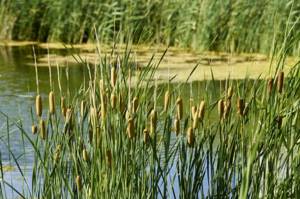
With the stem rigging method, it is best to tie the line to the hook last.
On the hair
The hair fishing method is suitable for fish weighing more than 3 kg.
It is done like this:
- Select young fresh reeds, tear off a leaf, divide in half lengthwise, divide each part into segments 2.5 cm long, stack them on top of each other in a stack about 3 cm high. You can make cuts, punctures, or rub a little on pieces of leaves to let out the juice.
- Place a piece of polystyrene foam measuring 1.5 x 1.5 cm onto the awl, then pierce the reed blank with it.
- Hook the hook of the sewing hook into the loop at the end of the hair and carefully move the entire stack onto it, securing it with a stopper.
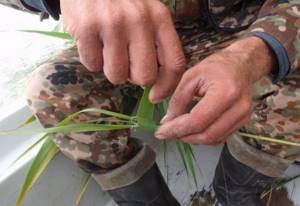
Catching grass carp on young reeds:
Grass carp is a fairly large fish, often reaching a weight of thirty kilograms. And this is certainly a worthy trophy for any fisherman.
Moreover, the value of such catch is determined not so much by the size of the fish, but by the complexity and art involved in catching grass carp. After all, this fish is considered one of the most cautious and powerful freshwater fish.
In addition, she only bites on food that is familiar to her - that which she eats constantly; it is impossible to lure her in with anything else.
What does grass carp eat?
The usual diet of grass carp is the vegetation of the reservoir in which it is distributed. Young animals feed on crustaceans and bloodworms, and as they grow up, cupid becomes a “convinced vegetarian” and eats algae, young shoots of reeds and any greenery in general, including flooded coastal vegetation. Based on this, the bait is selected.
Catching grass carp on reeds
One of the most favorite delicacies of wary fish are young shoots of reeds. Knowing this, experienced fishermen make bait in advance, which prepares for a successful catch of grass carp. For this purpose, the reed is cut from 50 centimeters to a meter in length, and its lower part is cleared of leaves.
If you simply put the prepared stem on a hook, then most likely nothing will come of such fishing. As mentioned above, grass carp is a very cautious fish, and any foreign object or its unnatural position will scare it away.
To catch grass carp successfully, you need to disguise the hook in the leaves left on top, and wrap the fishing line (several times) around the prepared stem. Neither a float nor a sinker are needed here, they will only get in the way.
The described structure should be thrown into a place that has been fed for three to four days (but not on the day of fishing), no further than one and a half meters from the growing reeds. It is best to feed the bait with dry corn, in an area with a radius of 4-5 meters, throwing most of the feed into the center.
Ideally, the bait reed remains afloat, and its cleaned end is submerged under water. Standing and watching when the bite starts will be a clear mistake. Grass Cupid walks overhead and, having noticed a person, will not approach the place where he saw him.
If possible, it is best to fish from the opposite bank, and if this is not possible, you need to provide good camouflage in advance.
Catching grass carp - fishing
Grass carp is a very strong fish, and this must be kept in mind when it is hooked. In no case should you immediately pull it towards you, as this could tear the fish’s lip or be left without gear. You should tire him out in large circles and only then, gradually pulling him up, take him into the landing net. If fishing occurs from the opposite bank, you need to be prepared for the fact that the cupid will move towards the fisherman.
Tackle
Catching grass carp is possible with any strong spinning rod with a good reel. The fishing line should be selected taking into account the weight of the intended prey - 0.3 or 0.6 millimeters in cross-section, hooks numbered 12-10. As already mentioned, floats or sinkers will be superfluous. To signal a bite, you can use a bell or focus on the crackling sound of the reel.
I wish you all successful fishing!
Source: https://www.syl.ru/article/84488/lovlya-belogo-amura-na-molodoy-kamyish
AMUR behavior on the water
Many anglers believe that catching fish such as silver carp and grass carp is very difficult. After all, these fish eat mainly only plant foods. In the article “Catching Silver Carp,” I already provided a link to a video tutorial on how to make one of the fishing tackles for silver carp.
Now I would like to share another tackle for supplying bait to these interesting, strong and tasty fish. Thanks to this tackle, you can count on stable bites from fish such as grass carp. So, I caught my first grass carp in a paid pond near the village.
Mikelevshchina, which is located in the Mostovsky district of the Grodno region of the Republic of Belarus. This reservoir is home to many different
types of fish: pike, perch, carp, crucian carp, grass carp, bleak.
The goal of my fishing was, of course, common and mirror carp. But we also came across well-fed crucian carp weighing 300-500g. I fished with different gear. Fishing was done from the bridge. The gear I used is called “spring fishing”.
But one carp rod was equipped with gear that I spotted on one of the fishing sites. Unfortunately, I didn’t remember the name of the site, but I saved the drawings from which I created my gear.
I would like to share some secrets in successfully catching grass carp with you.
I knew from the lake guard that grass carp lives in this reservoir. Based on the assumption that the bottom of the lake is covered with a layer of aquatic vegetation, I concluded that it was necessary to use floating equipment.
According to the stories of other fishermen, fishing with floating boilies did not bring results, since the fish in the lake were not accustomed to this bait.
Since canned sweet corn was used as the main bait, I used the following stationary tackle for catching carp (Fig. 1).
There is quite possibly nothing supernatural in this gear. Maybe you have had to deal with it too. Several carp were caught at other times using this equipment. But it was on this tackle that the grass carp got bitten for the first time. I did not use a weight with this equipment; a local delicacy was stuffed into the spring - millet porridge, to which several other ingredients were added.
The weight of this spring was enough to consistently throw the tackle into the baited area for fairly accurate casting. The hook used a hair rig with a foam ball and a few kernels of canned sweet corn. Before casting, you should always check whether the hook floats or sinks.
When casting, special attention must be paid to the following several points: firstly, so that the equipment does not get tangled when casting, secondly, since carp hooks are usually very heavy and thick, it was necessary to put on several foam balls, and thirdly, the fish sometimes went away at the moment of hooking.
Therefore, specifically, when fishing in your pond, you need to experiment with the nozzle. Not only hair installation can lead to a bite, but also baiting sweet canned corn and foam balls directly onto the hook. If the configuration of the carp hook allows, then you can put several grains of corn and foam balls on the hook in various combinations.
This tackle can also be used when fishing with float rods (Fig. 2). But here is a mandatory condition: it is necessary to feed the selected place from afar in order to catch grass carp from a boat. After all, grass carp is a very timid fish, and it will not stay in a place where something disturbs it.
Therefore, as a float rod, it is better to use a match rod for long casting with the appropriate test for such strong fish. The tackle needs to be slightly modernized according to the following picture. I also saved the drawing, but I did not use this equipment myself.
Therefore, I can’t say for sure about the catchability of this gear. However, I think it’s very possible to use it if fishing conditions allow. Another way to release the nozzle from the bottom can be achieved using an adjusting pellet.
In this case, the nozzle made of corn grains should be placed in a chain (Fig. 3)
It should be remembered that grass carp is a very strong fish. And fishing with it gives the fisherman real pleasure in our area. Having caught it, I gained respect for this strong and beautiful rival, which appeared in our Far East from the river, thanks to which it got its name.
Now watch the video, which shows how to properly fish for large fish, especially such strong and large fish as grass carp. Please note that the fishermen slowly enter the water themselves and, without rushing anywhere, bring the fish into the landing net. After all, such a large and strong fish as grass carp is capable of breaking any fishing line when approaching the shore.
Let this video be an excellent lesson for you, if such prey smiles on you, and you can catch grass carp.
See you on the website “Getting ready for fishing”
No tail, no scales!
Source: https://na-kruchok.ru/lovim-belogo-amura
Groundbait recipes
For float tackle
Below is a recipe that is ideal for fishing with float tackle. It has stood the test of time and consists of components that are always on hand. It can be used as the basis for your own unique recipe.
To prepare it, you need:
- 2 packages of universal store mix.
- 2 bananas.
- Black bread.
- 200 gr. steamed flour.
- Wheat porridge 1 kg.
- Canned corn.
The porridge needs to be boiled and mixed with store-bought bait. Then you need to soften the bread, mix with steamed flour and also add to the main composition. At the end bananas and corn are added. The resulting mixture is thoroughly mixed. The balls roll directly onto the pond.
Before starting fishing, about half of the mixture is thrown in this way, the remaining half is left for later to throw the balls during the fishing process.
Bait recipe for feeder (spring)
This type of feeder requires a mixture of a different consistency:
- Crumb of black bread.
- 3-4 potatoes.
- Wheat porridge 1 kg.
- A handful of canned corn.
- a glass of semolina.
- Banana 2 pcs.
Potatoes with wheat grits must be boiled. After this, the potatoes are peeled and finely grated. She mixes the porridge with the porridge in the pond. After mixing, the remaining ingredients are added one by one, except semolina, the composition must be kneaded to the desired thickness. It is important that the mixture stays firmly in the feeder. At the end, you can change the viscosity of the base using semolina.
Catching grass carp on reeds
Home » Articles about fishing » Catching grass carp with reeds
Despite the fact that grass carp is a herbivorous fish, sometimes it is sorely lacking in food and this is not surprising, because it eats twice its weight in a day.
Catching carp on reeds
Fishing for carp, the gear for which must be strong, since the fish is very strong, is carried out in warm, calm weather. Young plants are usually used as bait.
Catching carp using reeds is very effective. But in order for such bait to serve the fisherman well, it is important to adhere to several rules.
Reeds no longer than 1 m are cut, and there should be young leaves and shoots on the stem.
It is known that this individual searches for food both at the bottom and at the very surface of the reservoir, therefore, when the stem of the reed falls into the water, grass carp suddenly grabs it.
This type of fishing has its own subtleties:
- First, you need to learn how to present the bait correctly. The hook should be carefully disguised in the leaves of the reeds, and the fishing line should be wound around the stem.
- Secondly, make the correct cast, which is done at the very edge of the reed thickets. Thirdly, it is better for the reed to remain afloat, then it will arouse keen interest among the fish.
- Fourthly, if there are no foreign objects around the bait, there is a greater chance that cupid will pick it up. The float in this case will only get in the way.
When fishing, it is important to maintain complete silence so as not to arouse suspicion among very cautious and shy fish.
Catching carp with boilies
Boilies (protein balls) can also attract herbivorous carp. According to experienced fishermen, the success of such fishing will depend on how well the place is baited, as well as on the smell of the boilie and its quality.
The balls can have a variety of shapes and contain proteins and carbohydrates. You can buy them in the store, but many fishermen make this bait themselves, according to their own recipe.
Since cupid is a fairly large fish, the boilies themselves must be large and hard. The consistency of the ball depends on their composition and cooking time. However, no matter what the taste of this bait is, it should not dissolve in water for a long time, since the waiting period for fish can last for several hours.
Balls with a diameter of 1.5-2 cm are optimal for catching carp. The main components for their production are flour, proteins (milk powder), substances containing animal protein (dried blood, meat and bone meal). To make the bait hard, eggs are added to the dough. Boilies are painted in different colors.
Boil them for 2-3 minutes, then dry and freeze.
Balls are not placed on the hook because their weight can reduce the effectiveness of hooking. In this case, equipment for hair fishing is more suitable.
To do this, you need a hook with an eye and a short piece of soft and thin braiding (the so-called hair).
A hair is tied to the hook, the boilie is pierced with a thin crochet hook and strung on the hair, and several balls can be strung on one hair. For better buoyancy of the bait, pieces of foam plastic are placed along with the balls.
Catching carp with boilies is very effective if at the beginning of fishing you feed with corn and several balls thrown into the water.
Catching carp on a feeder
No less popular in our country is fishing for grass carp using a feeder, which provides many advantages in hunting for large fish. Provides long-range accurate casting, allowing you to simultaneously feed and catch fish. In addition, such tackle is very sensitive.
The feeder rod must be at least 3.6 m. Braided or monofilament with a diameter of 0.2-0.3 mm is suitable as a fishing line.
With this method of fishing, special attention is paid to the bait. Corn, cabbage leaves, willow leaves, dandelion stems, pea pods, dough are perfect here.
Cupid will also like classic baits: boilies, worms, maggots, wheat. For bait, you can use a dry mixture with the addition of loosening ingredients.
When they enter the water, they loosen the lump and create turbidity in the fishing area, which attracts fish.
For feeder fishing, you can use methods of installing a feeder such as a loop system and an anti-twist tube.
So, the place has been baited, now you can make the first cast. As practice shows, after the gear is in the water, the first bite appears within a few minutes.
Feeder fishing is carried out at long distances from the shore. Having chosen a place, you can throw the filled feeder. After throwing the tackle, you need to carefully monitor the float.
The cupid takes it carefully, which is sometimes imperceptible to the fisherman’s eyes. When the fish swallows the bait, the float at the same moment goes under the water or to the side.
It is important to react in time and quickly make a hook, otherwise the fish will go into the thicket, where it can easily tangle the tackle and break the line.
Catching carp on a donk
Fishing for carp is often done using bottom equipment. In this case, the baits are bread, dough, bloodworms, and worms. The bite begins in early spring and lasts until mid-autumn.
In order for fishing to bring a rich catch, it is important to choose the right places for fishing. These are, first of all, areas with a lot of vegetation, nearby reed beds and small islands.
The fisherman should also know that grass carp loves clean water and rarely visits muddy parts of the reservoir.
Catching carp with a donk is used when you need to fish far from the shore, for example, at a distance of 30 m. The best hours for fishing are from 5 a.m. to 9 p.m. The bite is determined by the tip of the rod.
Since the fish sucks the bait quite slowly, a bite may take several minutes. In this case, the cupid will slowly and strongly tug on the rod. It is important to seize the right moment and make a timely hook.
Many are sure that such a gourmet fish will not be interested in bait and therefore it is practically impossible to catch it. However, as many years of experience of avid fishermen show, grass carp, which has a special diet, often does not refuse another type of food. Fishing is especially successful in the spring - autumn period, on windless, sunny days.
Happy fishing!
fishingday.su
Encyclopedia of Fisherman and Hunter
After grass carp was brought to the European part of the country in the sixties, it became possible to catch this fish of the carp family not only on the Amur, but also on the Volga and Don. Which is what we suggest you do, since this process is quite exciting.
Grass carp bite more readily either in the spring, as soon as the average air temperature begins to exceed plus 10 degrees, or in the fall, when there is no longer enough food in the reservoir for it, a purely herbivore. Fishing for carp in summer is more successful on sunny but cool days without strong winds.
How cupid bites
Considering the very large size of the fish (length up to 1.2 meters, weight up to 32 kilograms!), you need to choose a stronger fishing rod for it.
This can be a donka for silver carp, a feeder or boilie blind tackle.
The bite happens instantly; If you don’t just as quickly take the fish to the shore, it will have time to turn around and hide in the reeds or somewhere under a snag, from where it most likely cannot be retrieved.
Do you know for sure that grass carp live in this place? Feed him properly, preferably corn. Throw half of the mixture into the middle of the point suggested to you, scatter the rest within a radius of up to five meters.
It is also recommended to catch carp on corn or the stems of this plant in the stage of milky ripeness. Also suitable are a cucumber ovary with an inflorescence attached to a hook, aloe leaves (don’t forget to cut off the thorns), and balls of cucumber-smelling mulberry algae that grows along the banks of reservoirs. Reed bait is also good.
Baits and lures
To attract it, you can use a variety of baits not only of plant origin.
- Animal origin . Even though it is a peaceful fish, some animal baits work well for it. In particular, we are talking about bloodworms, maggots or worms .
- Vegetable origin. Most plant baits will suit her.
It is important to choose ones that will stick well to the hook.These include various
filamentous algae, corn kernels or cucumber pieces .
